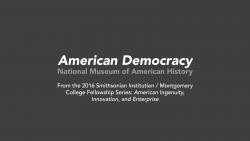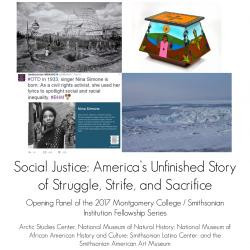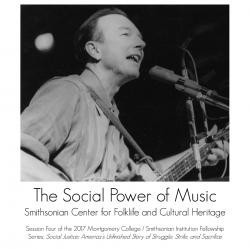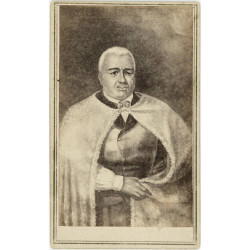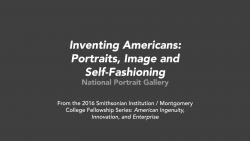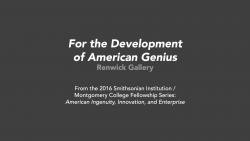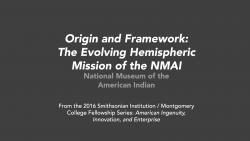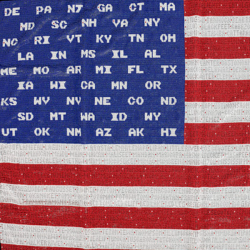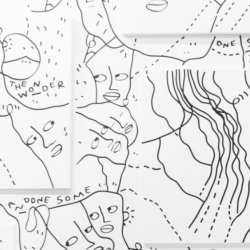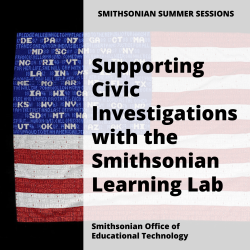Tess Porter
User Experience Strategist (she/her)
Smithsonian Office of Educational Technology
I'm the former User Experience Strategist at the Smithsonian Office of Educational Technology. Here, I focused on the use of digital museum resources to support teaching and learning. My work draws on my experience as a museum educator, digital analyst, usability researcher, and content designer. I hold a B.A. in Anthropology and a B.A. in Art History from University Colorado Boulder, and an M.S. in Museums and Digital Culture with an Advanced Certificate in User Experience from Pratt Institute.
Tess Porter's collections
Flashcard Activity: Tools and Innovation
<p>This collection traces innovation in various types of tools over time. Approach in small groups or as a classroom to have students explore the essential questions: What makes something innovative? How do you define innovation? </p>
<p>Supporting questions and activity implementation ideas are located under this collection's Information (i) button. This activity works equally well online or using printed flashcards (see <a href="https://learninglab.si.edu/collections/flashcard-activity-tools-and-innovation/R998xYb5Lbjw4bHE#r/860422">the resource tile</a> at the end of this collection). <br></p>
<p>Keywords: invention, flash cards, conceptual understanding</p>
 Tess Porter
Tess Porter
37
American Ingenuity, Innovation, and Enterprise: National Museum of American History Seminar Resources
<p>This collection previews the fifth and final seminar of the 2016 Montgomery College / Smithsonian Institution Fellowship seminar series. Fellows will visit the National Museum of American History to explore the issues and topics surrounding the upcoming exhibition, "American Democracy: A Great Leap of Faith." Harry Rubenstein, Curator and Chair of the Division of Political History, will lead the seminar.</p>
<p>Included in this collection: bio of presenter, presentation description, and resources for attendees to explore before attending the session. The first two resources in this collection - the video "Bill Geist with curators Harry Rubenstein and Larry Bird on the campaign trail, 1996" and image "Where is Democracy" with attached quiz question - are required. The others are not, but will help fellows prepare for discussion the day of the seminar.</p><p>#MCteach<br /></p>
 Tess Porter
Tess Porter
7
Social Justice: Opening Panel Resources
<p>This collection previews the opening panel of the 2017 Montgomery College / Smithsonian Institution Fellowship seminar series, <em>Social Justice: America's Unfinished Story of Struggle, Strife, and Sacrifice</em>. Four Smithsonian staff members will speak at this event: Igor Krupnik (Arctic Studies Center, Department of Anthropology, National Museum of Natural History), Lanae Spruce (National Museum of African American History and Culture), Ranald Woodaman (Smithsonian Latino Center), and E. Carmen Ramos (Smithsonian American Art Museum).</p>
<p>Each text annotation in this collection contains each speaker's presentation title, description, and bio. Following each text annotation are resources and questions chosen by the presenters for participants to consider before the panel itself.</p>
<p>#MCteach<br /></p>
 Tess Porter
Tess Porter
17
Eudora Welty: Examining Portraiture
<p>This teacher's guide provides a portrait and analysis questions to enrich students' examination of Eudora Welty, a Pulitzer Prize-winning author known for her evocative novels and short stories set in the American South. Includes the video "Defining Portraiture: How are portraits both fact and fiction?" and the National Portrait Gallery's "<em>Reading" Portraiture Guide for Educators, </em>both of which provide suggestions and questions for analyzing portraiture. Also includes a video and blog post that look closely at this portrait, as well as a related article about Mississippi's new writers trail that may be used as a lesson extension.</p>
<p>Consider:</p>
<ul><li>How is this portrait both fact and fiction?</li><li>How does this portrait reflect how Eudora Welty wanted to be seen, or how others wanted her to be seen? Consider for what purpose this portrait was created.</li><li>Having read one of her stories, does the portrait capture your image of Eudora Welty? Why, or why not?</li><li>If you were creating your own portrait of Eudora Welty, what characteristics would you emphasize, and why?<em></em></li></ul><p>Keywords: mississippi, ms, story, optimist's daughter, writer, #BecauseOfHerStory</p>
 Tess Porter
Tess Porter
6
American Ingenuity, Innovation, and Enterprise: Opening Seminar Resources
<p>This collection previews the opening panel of the 2016 Montgomery College / Smithsonian Institution Fellowship seminar series. Three Smithsonian staff members will speak at this event: Tricia Edwards of the National Museum of American History, Doug Herman of the National Museum of the American Indian, and Josh Bell of the National Museum of Natural History.</p>
<p>Included in this collection: presenter bios, presentation titles and descriptions, and resources chosen by presenters for attendees to explore before attending the session. These resources are not required readings - instead, they provide guiding questions and background information to help prepare for discussion the day of the seminar.</p><p>#MCteach</p>
 Tess Porter
Tess Porter
12
American Ingenuity, Innovation, and Enterprise: National Portrait Gallery Seminar Resources
<p>This collection previews the third seminar of the 2016 Montgomery College / Smithsonian Institution Fellowship seminar series. Fellows will visit the National Portrait Gallery, explore the exhibitions, and learn strategies for examining portraiture in the classroom. Two National Portrait Gallery staff members will lead this seminar: David C. Ward, Senior Historian, and Briana Zavadil White, Student and Teacher Program Manager.</p>
<p>Included in this collection: presenter bios, presentation description, and resources chosen by the presenters for attendees to explore before attending the session. Fellows will be asked to discuss their answer to the quiz question during the seminar. Other resources are not required, but will help fellows prepare for discussion the day of the seminar.</p><p>#MCteach<br /></p>
 Tess Porter
Tess Porter
6
William Faulkner: Examining Portraiture
<p>This teacher's guide provides portraits and analysis questions to enrich students' examination of William Faulkner, an American author and Nobel Prize laureate. Includes the video "Defining Portraiture: How are portraits both fact and fiction?" and the National Portrait Gallery's "<em>Reading" Portraiture Guide for Educators, </em>both of which provide suggestions and questions for analyzing portraiture. </p>
<p>Consider:</p>
<ul><li>What do these portraits have in common? How are they different?</li><li>How are these portraits both fact and fiction?</li><li>How do these portraits reflect how they wanted to be seen, or how others wanted them to be seen? Consider for what purpose these portraits were created (such as the caricature, stamp, etc.).</li><li>Having read one of his stories, does the portrait capture your image of William Faulkner? Why, or why not?</li><li>If you were creating your own portrait of William Faulkner, what characteristics would you emphasize, and why?</li></ul><p>Keywords: mississippi, ms, the sound and the fury, writer</p>
 Tess Porter
Tess Porter
6
Homo floresiensis: Teaching Resources
<p>This topical collection gathers resources related to Homo floresiensis, commonly known as the Flores “Hobbit." H. floresiensis, was discovered in 2003, making it the second most recently discovered early human species. Contains a video, websites, a 3D interactive tour, and articles.</p><p>Keywords: physical anthropology</p>
 Tess Porter
Tess Porter
7
Richard Wright: Examining Portraiture
<p>This teacher's guide provides portraits and analysis questions to enrich students' examination of Richard Wright, an American author whose works investigate the toll that racial prejudice exerted on society. Includes the video "Defining Portraiture: How are portraits both fact and fiction?" and the National Portrait Gallery's "<em>Reading" Portraiture Guide for Educators, </em>both of which provide suggestions and questions for analyzing portraiture. </p>
<p>Consider:</p>
<ul><li>What do these portraits have in common? How are they different?</li><li>How are these portraits both fact and fiction?</li><li>How do these portraits reflect how they wanted to be seen, or how others wanted them to be seen? Consider for what purpose these portraits were created (such as the stamp, etc.).</li><li>Having read one of his stories, does the portrait capture your image of Richard Wright? Why, or why not?</li><li>If you were creating your own portrait of Richard Wright, what characteristics would you emphasize, and why?</li></ul><p>Keywords: mississippi, ms, writer, native son</p>
 Tess Porter
Tess Porter
6
Supporting Civic Investigations with the Smithsonian Learning Lab
<p>Created to support the 2022 <em>Smithsonian Summer Sessions</em> workshop, “Supporting Civic Investigations with the Smithsonian Learning Lab,” this collection gathers resources and pedagogical approaches to investigate "the people" as a political concept with students. This collection is inspired by Educating for American Democracy's content theme, <a href="https://www.educatingforamericandemocracy.org/the-roadmap/7themes/#we-the-people" target="_blank">We the People</a>.</p>
<p>The 2022 <em></em><em>Smithsonian Summer Sessions: Inspiring Civic Engagement </em>is a virtual professional development opportunity. Held synchronously in late June 2022, it will be made available as a free, asynchronous virtual course in Fall 2022. </p>
<p>#SummerSessions</p>
 Tess Porter
Tess Porter
26
National Portrait Gallery’s Asian Pacific American Portraiture (Artists & Sitters)
<p>This topical collection contains portraits and artwork that depict or were created by Asian Pacific Americans. Leslie Ureña, National Portrait Gallery Assistant Curator of Photographs, curated this group of resources from the National Portrait Gallery’s ever-expanding collections. A list of the museum’s collections on this topic is included as the second resource. <br /></p>
<p>Teachers and students may use this collection as a springboard for classroom discussion; for example, this collection may inspire students to conduct research about other Asian Pacific American artists and individuals. This collection is not comprehensive, but rather provides a launching point for further research and study. </p><p><em>This Smithsonian Learning Lab collection received Federal support from the Asian Pacific American Initiatives Pool, administered by the Smithsonian Asian Pacific American Center. </em> <br /></p>
<p>Keywords: portraiture, photograph, sculpture, article, primary source, painting, poster, letter</p>
<p>#APA2018</p>
 Tess Porter
Tess Porter
122
Identity, Community, and Fire Hats
<p>What can objects reveal about the values and beliefs of the people who created them? Explore fire hats, worn by volunteer fire fighters on the East Coast during the 1800s. Created for use during both fires and parades, these ornate hats contain symbols – historical figures, allegorical images, patriotic scenes, and more – that proclaim the wearers' cultural and political identity, as well as their positions on religion and immigration. What symbols do you see?</p>
<p>This collection contains a small selection of fire hats from the Smithsonian. To continue exploring, <a href="https://learninglab.si.edu/search/?f%5B_types%5D%5B%5D=resource&st=fire%20hats&providers%5B%5D=National%20Museum%20of%20American%20History&s=&page=1">search for fire hats in the Smithsonian Learning Lab</a>. </p>
 Tess Porter
Tess Porter
12

